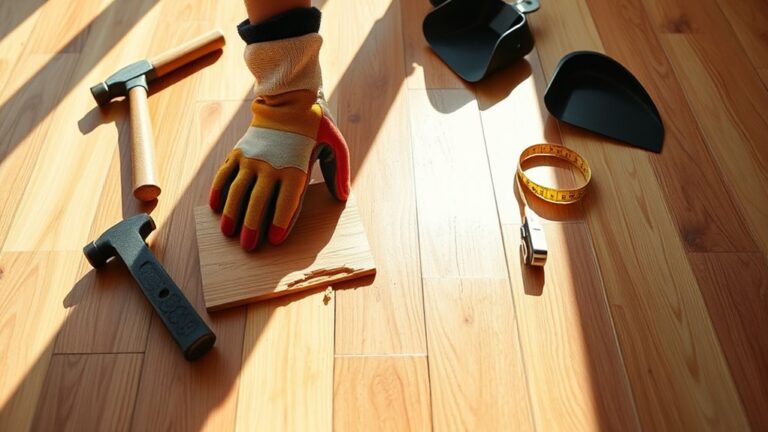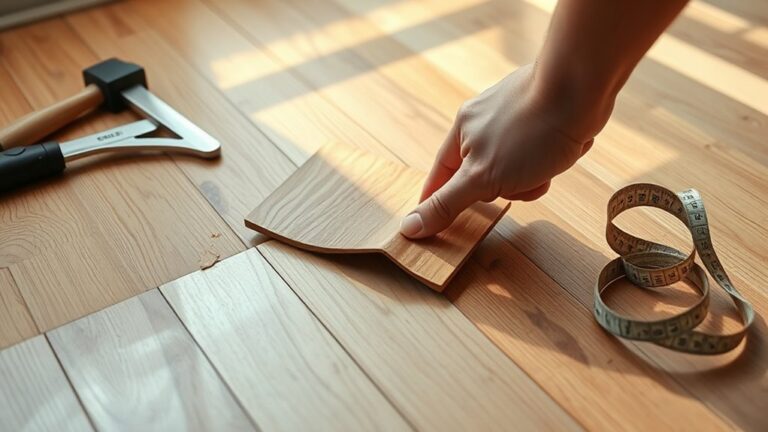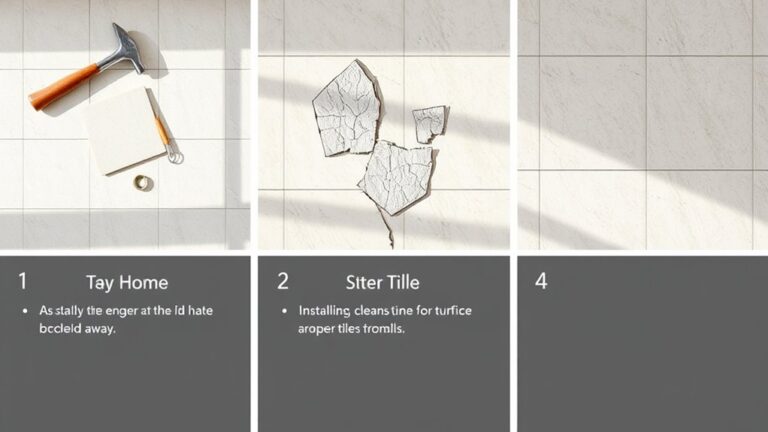When installing flooring on uneven surfaces, you must first assess your subfloor for irregularities like slants and dips. Use self-leveling compounds to fill deeper lows and sand down high spots. Make sure your subfloor is clean and dry for ideal adhesion. Consider flexible flooring options like luxury vinyl or carpet, which can better accommodate minor imperfections. Avoid rigid materials like ceramic tiles that may crack. If your subfloor's issues are severe, consulting a professional can provide tailored solutions. For detailed methods and further techniques, exploring deeper into this topic might reveal valuable insights.
Assessing Your Subfloor Conditions
Before you plunge into your flooring installation, it's important to assess your subfloor conditions. Start by checking for any irregularities like slants, bumps, or dips that could impact your flooring's performance. Uneven floors can lead to significant problems such as creaking noises and potential movement of the boards, so identifying these issues early is imperative.
Measure the gradual changes in height across your subfloor. Small variations, up to 1/16 inch, are generally acceptable, but anything larger may necessitate leveling solutions. If you find substantial discrepancies, consider consulting a professional for an accurate assessment. Their expertise can help pinpoint any necessary repairs or leveling before your new flooring goes down.
Understanding the type of subfloor material is also essential. Different materials may react differently to corrective measures, so knowing what you're working with will guide you in determining the right approach. Common materials include plywood, concrete, and OSB, each presenting unique challenges when it comes to unevenness.
Don't skip this important evaluation phase. A stable and durable flooring foundation starts with a properly assessed subfloor. By taking the time to identify and address any issues now, you'll set yourself up for a successful and lasting flooring installation. Remember, your freedom to choose beautiful flooring depends on the integrity of the surface beneath it.
Flexible Flooring Options
When evaluating flooring options for spaces with uneven surfaces, flexibility is key. You want a solution that not only accommodates the imperfections but also enhances the overall aesthetic of your space. Carpet is one of the best choices here; it's cost-effective, easy to install, and does an excellent job of concealing surface irregularities. If you're looking for something a bit more durable, luxury vinyl plank flooring is a fantastic alternative. It provides a full coverage illusion on slightly uneven surfaces while being both durable and visually appealing.
Laminate flooring, whether in sheets or tiles, offers versatility for uneven floors, but keep in mind that if it's not installed correctly, existing imperfections may become visible. For those seeking a highly durable option, epoxy flooring can be a game-changer. When installed properly, it can effectively even out floors while allowing for a customizable appearance that suits various design preferences.
It's vital to reflect on the thickness of the flooring you choose. Thicker options tend to be more prone to breakage, especially when laid over sharp corners or significant surface irregularities. As a result, balancing durability with flexibility is essential when installing flooring on uneven surfaces. By selecting the right materials and following best practices, you can achieve a beautiful floor that stands the test of time while accommodating the quirks of your space.
Preparing the Subfloor
Before you install your new flooring, you need to assess the subfloor's condition for any irregularities like bumps or dips. If you find any issues, use leveling techniques, such as self-leveling compounds or sanding high spots, to create a flat surface. A clean, smooth subfloor is essential for ensuring proper adhesion and the long-term performance of your flooring.
Assessing Subfloor Condition
Evaluating the condition of your subfloor is vital for a successful flooring installation. Start by thoroughly examining the subfloor condition, looking for irregularities like slants, bumps, or dips that could disrupt the stability of your new flooring. Identifying the material of your subfloor is important, as different materials may require specific leveling techniques or repair methods to create a flat surface.
For an uneven subfloor, consider obtaining a professional inspection. This can provide an accurate evaluation and help you pinpoint the underlying causes of unevenness, guiding you towards appropriate solutions. If you're facing minor dips, self-leveling compounds can be effective on both concrete and wood subfloors, creating a smoother base for installation.
Before you proceed with laying down your flooring, confirm that the subfloor is clean, dry, and free of debris. Any contaminants can compromise adhesion and the longevity of your flooring material. By carefully evaluating the subfloor condition, you'll set the stage for a successful, durable installation that meets your expectations.
Leveling Techniques Overview
Leveling your subfloor is a crucial step in preparing for flooring installation, ensuring a stable and even surface for your chosen material. To achieve this, you'll want to evaluate several leveling techniques. First, self-leveling compounds are an excellent choice. These mixtures of powder and water flow into dips and irregularities, creating a smooth surface on both concrete and wood subfloors.
If you encounter high spots or humps, grinding or sanding might be the answer. These methods effectively remove excess material and are often used alongside self-leveling compounds to maximize results. It's essential to assess the severity of your subfloor's unevenness; mildly uneven surfaces may only need minor adjustments, while severely uneven floors will require more thorough leveling efforts.
Installing Hardwood on Uneven Floors
Installing hardwood flooring on uneven floors presents unique challenges that require careful planning and execution. To achieve a stable and long-lasting finish, you'll need to smooth out the surface with underlays and resurfacing techniques. A thorough assessment of the floor's condition is critical before starting your flooring installation. This guarantees you identify any necessary preparations.
For concrete surfaces, sanding and polishing are often essential to create a level base before laying hardwood. If your floors are only slightly tilted, consider using engineered hardwoods, as they offer greater flexibility for installation compared to solid hardwoods.
Here's a quick reference table to help you navigate the preparation process:
| Step | Action |
|---|---|
| Assess Floor Condition | Inspect for unevenness and damage |
| Raise the Subfloor | Use underlayment or leveling compound |
| Choose Flooring Type | Opt for engineered over solid hardwood |
Confirming that the subfloor is adequately prepared not only prevents future issues but also enhances the overall durability of your hardwood flooring. Remember, taking the time to properly prepare your surface will pay off in the long run, providing you with a beautiful and stable floor that stands the test of time. By following these guidelines, you can tackle the challenge of installing hardwood on uneven floors with confidence.
Flooring Types to Avoid
When considering flooring options for uneven surfaces, it's crucial to steer clear of certain materials that can exacerbate problems. Ceramic tiles, particularly larger formats, are highly prone to cracking when installed on uneven surfaces. Their lack of flexibility means they can't accommodate imperfections in the subfloor, leading to potential damage. Similarly, porcelain tiles exhibit this susceptibility, making them unsuitable for such installations.
Natural stone flooring is another material to avoid. It's not only vulnerable to damage from uneven subfloors but also often results in costly repairs or replacements if not installed correctly. Additionally, hard flooring options like hardwood or laminate can create significant issues. When installed on uneven surfaces without proper leveling, you may experience creaking noises and movement of boards over time, which can compromise the longevity and aesthetic of your flooring.
In these scenarios, consulting with professionals is crucial. They can help identify durable flooring solutions tailored to your specific needs. Remember, uneven floors might indicate underlying structural problems that need addressing before any flooring installation can take place. Ignoring these issues can lead to more significant headaches down the line. To summarize, avoid ceramic, porcelain, natural stone, and hard flooring types unless you're willing to invest in proper leveling techniques, as these materials will likely lead to frustration and additional costs.
Leveling Techniques for Uneven Surfaces
When you're facing uneven surfaces, self-leveling compounds can be a straightforward solution, as they flow to create a level base. For more significant height discrepancies, consider installing plywood sheets to provide a stable subfloor. Assess the severity of the unevenness first to determine the best approach for your flooring project.
Self-Leveling Compounds Overview
Achieving a level surface is essential for the successful installation of flooring, especially on uneven subfloors. Self-leveling compounds are a practical solution, designed to create a smooth, flat surface by pouring a mixture of powder and water that levels itself through gravity. They're versatile and suitable for both concrete and wood subfloors.
Here are some key points to take into account when using self-leveling compounds in your installation process:
- Preparation: Clean and prime the subfloor thoroughly to guarantee proper bonding.
- Thickness: Apply the compound at least 1/8 inch thick; in severe cases, you can build it up to several inches.
- Curing Time: Allow the compound to cure for about 24 hours before installing new flooring.
- Mixing: Follow the manufacturer's instructions for mixing ratios to achieve the best consistency.
Plywood Installation Benefits
Installing plywood over uneven surfaces offers several advantages that can greatly enhance the flooring installation process. First and foremost, plywood installation creates a stable and level sub-floor, which minimizes flexing issues and provides a solid foundation for various flooring types, including laminate and vinyl. Using 3/4 inch plywood is vital for its strength and durability, effectively bridging gaps and compensating for height differences between uneven areas.
Additionally, plywood considerably reduces the risk of creaking noises and board movement that often occurs on uneven subfloors, enhancing the overall longevity of your flooring. To guarantee the best results, it's important to properly secure the plywood to the sub-floor. This step prevents future movement and instability, which could lead to flooring damage.
Moreover, using plywood as a leveling technique allows for easier installation of any flooring type. It provides a uniform surface that meets the manufacturer's installation requirements. Overall, by choosing plywood installation, you're not only addressing the challenges of uneven surfaces but also paving the way for a more durable and reliable flooring solution.
Transition Solutions for Height Differences
Shifting between different flooring types can present challenges, especially when height differences arise. To guarantee a smooth shift and prevent tripping hazards, you need to take into account effective shift solutions that cater to these height variations. Here are some practical options to keep in mind:
- Transition Strips: These are designed to bridge height differences between two flooring types. Make sure to select the right type based on the flooring materials involved.
- Tapered Transition Strips: For gradual height changes, these strips blend the difference seamlessly, creating a smoother shift that enhances both function and aesthetics.
- Thicker Transition Strips: When dealing with significant height variations, opting for a thicker transition strip might be necessary. This guarantees proper alignment and stability, preventing future issues.
- Custom Solutions: In certain situations, you may need to create a custom shift solution. This could involve adjusting the height of the subfloor or using specialized materials to achieve the desired look and functionality.
Proper installation of these shift solutions is essential. Poorly fitted shifts can lead to misalignment, increased wear, and potential damage to your flooring over time. By taking the time to choose and install the right shift methods, you can create a safe, aesthetically pleasing environment that respects the unique characteristics of each flooring type. So, don't overlook this fundamental step in your flooring installation process!
Importance of Professional Consultation
When initiating a flooring project, seeking professional consultation can be a game changer. Engaging experienced flooring professionals guarantees accurate assessments of your flooring conditions and sub-floor issues. This step helps you make informed decisions regarding installation methods and materials, especially when faced with uneven surfaces. Professionals can identify underlying structural problems that might not be visible to you, preventing costly mistakes during the installation process.
Understanding the specific tolerances and requirements of different flooring types is essential. A professional's advice can guide you on the best leveling methods tailored to your situation, whether it involves self-leveling compounds or plywood additions based on the severity of sub-floor imperfections. This targeted approach enhances the overall performance and durability of your flooring.
Here's a quick overview of the benefits of professional consultation:
| Benefit | Description | Importance |
|---|---|---|
| Accurate Assessments | Professionals evaluate flooring and sub-floor issues | Guarantees informed decisions |
| Identification of Structural Issues | Uncovers hidden problems | Prevents costly installation mistakes |
| Tailored Recommendations | Offers customized solutions for leveling | Improves flooring durability and performance |
| Adherence to Standards | Guarantees compliance with manufacturer guidelines | Enhances overall quality of installation |
Incorporating professional consultation into your flooring project not only supports proper installation but also grants you the freedom to confidently enjoy your space, knowing that expert insights have been applied.
Long-Term Maintenance Considerations
While maintaining your flooring might seem straightforward, several long-term maintenance considerations are vital for ensuring its durability, particularly on uneven surfaces. By incorporating these practices, you can enhance the lifespan of your flooring and preemptively address potential issues.
- Regular Inspections: Schedule regular checks of the flooring surface to spot any signs of wear, cracks, or shifts. Early detection is key to mitigating problems stemming from underlying unevenness.
- Use Area Rugs: Placing area rugs in high-traffic zones can help distribute weight evenly. This reduces stress on the flooring, extending its durability on uneven surfaces.
- Humidity Control: Maintaining proper humidity levels in your home is essential. Fluctuations can cause expansion or contraction of flooring materials, particularly in hardwood or laminate installations, leading to potential damage.
- Cleaning Techniques: Clean your flooring with appropriate products and methods to prevent dirt buildup. Dirt can worsen existing unevenness and contribute to premature wear and tear.
Additionally, scheduling periodic professional assessments will provide valuable insights into the condition of both the flooring and subfloor. This proactive approach aids in the early detection of potential issues related to uneven surfaces, allowing you to act before they escalate. By committing to these long-term maintenance considerations, you'll not only preserve the integrity of your flooring but also enjoy its beauty and functionality for years to come.
Frequently Asked Questions
How to Lay Flooring on Uneven Surfaces?
Laying flooring on uneven surfaces can feel like maneuvering a bumpy road. Start by evaluating the subfloor for imperfections. Choose appropriate flooring materials like luxury vinyl plank, which adapts well to slight variations. Use installation techniques such as self-leveling compounds to create a smooth base. Don't forget to clean the surface thoroughly and address any debris. Following the manufacturer's guidelines will guarantee your project stands strong against time and temperature changes.
What to Do if the Floor Isn't Level?
If your floor isn't level, you'll need to contemplate effective flooring solutions. Start by evaluating the irregularities; for minor dips, apply leveling techniques like self-leveling compounds. For more pronounced issues, you might have to grind down high spots. Additionally, installing a plywood underlayment can stabilize the base if height adjustments are necessary. Don't forget to leave an expansion gap around the perimeter to accommodate movement from temperature changes.
Can Vinyl Plank Flooring Be Installed on Uneven Floors?
Imagine walking into your dream home, only to find uneven floors threatening your vision. Don't worry, you can still enjoy vinyl plank advantages, like flexibility and affordability. If your floors have minor imperfections, you can use effective flooring installation techniques to lay down the planks. For larger dips, consider leveling compounds. This way, you'll achieve a beautiful, seamless look without sacrificing the comfort of your home.
What to Do if the Subfloor Is Not Level?
If your subfloor isn't level, you'll need to tackle that before installation. Start with thorough subfloor preparation; clean the area to remove any debris. For minor dips, consider using self-leveling compounds as a leveling technique. If you have significant unevenness, grinding or sanding down high spots will help create a more uniform surface. Always assess the extent of imperfections to choose the right method for achieving a level subfloor.




